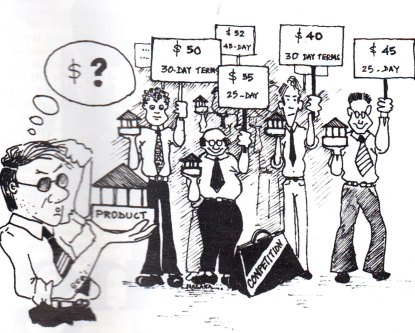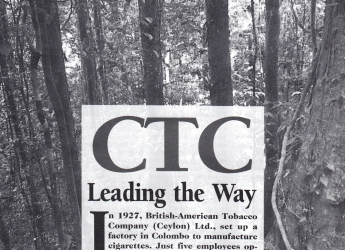Marketers all over the world, not just in this country, face a major challenge today, in one aspect of marketing-Pricing. The volatility in the marketplace urge many marketing and credit managers today to expend greater amounts of time and energy in discovering the best prices for their products.
Strategic and competitive pricing to increase market share is a major concern when it comes to selling merchandise and services. For instance, Lever Brothers and Procter & Gamble spend a great amount of managerial talent in pricing their soaps and detergents Automobile giants Ford and General Motors price their vehicles after thorough research and thought. Consumer durable marketers such as General Electric and Samsung do the same. These companies have discovered the importance of a sound pricing policy early enough. Of course, in their kinds of markets, such a pricing policy needs to be the norm, not the exception.
Pricing is always important. Agreed. But an excessive focus on dirhams, dollars or yen may be narrow and ultimately unrewarding. A more comprehensive approach is suggested in the saying. “You set the price, I’ll set the terms”. Drawn from the world of business negotiations, this concept suggests that a creative review of terms and conditions is very helpful when it comes to placing products or services in the marketplace. This is what I would call “creativity in pricing.”
For example, consider the routine use of 30-day terms, which, for most organizations are the standard. Recently, I have been discussing this dimension of pricing with the CEO of a small manufacturing firm in competition with a major manufacturer. The owner of the small firm indicated that he set his terms as net 30-days because his major competitor did so. I checked out whether the price of his product was the same as that of his competitor. It wasn’t. The small company’s product was 25% cheaper. I was surprised at his decision of sticking to similar terms and conditions. I asked him Why not make your terms different? What about net 10-day terms, net cash or net 15-day terms?
Although the owner of the small company was selling his product for less money, there was no reason why he should not have explored the possibility of recovering some of his initial price loss through a better cash flow, created by different sales terms.
To be successful, one must manage the cashflow better today. And marketing professionals cannot ignore this financial part as being different from the 4 Ps of marketing mix. It is very much an integral part of marketing and sales, and many companies have started appointing finance managers for sales operations and fund management. Everyone would like to realise their money immediately. Small companies all the more because their purse strings are tighter.
Some major companies are also prone to this problem. For example, a leading conglomerate in the Indian sub-continent, which has interests in consumer durables, manufacturing, trading, services and supermarket chains, always. likes to get its money immediately. To overcome its cashflow problem, it insists on a no-credit policy all the time. And it has managed to get away with this for the last many years. This is because its pricing policy had been excellent in both conception and implementation. Of course, with products which were in virtually monopolistic areas earlier, it would not have had problems with this no-credit policy. But, in the years to come, with so much. competition and uncertainty in the marketplace, it would be tougher for the organization to get away like this.

To be an effective factor in establishing the overall price, discounts to trade have to be considered carefully. Discounts must be made with a consideration of effective money management. Remember that many individuals are content to pay in 45 instead of 30 days. Evaluate discounts from that point of view.
Because many organizations take advantage of discounts, the payment incentive can be an effective price condition only if the percentage of the discount is in proportion to the overall interest rate.
Discounts can also be abused. Many companies take unauthorised discounts through methods that become very inventive. One tactic involves taking a discount, dating the payment within the discount terms (for example, net 15- days), holding the cheque, and then paying in 30 plus-days. Although these actions sometimes just involve honest mistakes, it is important to review and clarify these situations to avoid setting a precedent.
Some companies insist on blank cheques, payable to the company, and they use it whenever delivery is made. They also charge heavy interests on dishonoured cheques to discourage such instances. Occasionally, they stop further supply as well. However, this method seems to cause a lot of financial crimes in recent times and it would probably help all concerned if companies and financial institutions abandon this method of collateral.
Terms and conditions do not have to be short to be effective. Those involved in the pricing policy preparation may do well to ask some of the following questions whenever they anticipate a price change:
• Have we looked at our terms and conditions lately?
• Do we really have to maintain the same terms and conditions as our competitors?
• Can we lower our price if we change our terms from net 30-days to net 10-days or COD cash in advance?
• Should we give discounts? If so, what type?
• Should we charge interest on the past due accounts and make that interest part of our terms and conditions?
• Should we develop a minimum order requirement before credit is extended?
• Should we offer special credit schemes during bumper sales? If so, should it be offered to all our customers or just the big ones only?
Many marketing and sales considerations are all part of major price changes. So, the need. for creativity is inherent in this as it is in all the other aspects of marketing. However, managers should always remember that in terms of cash flow, TIME IS MONEY!




